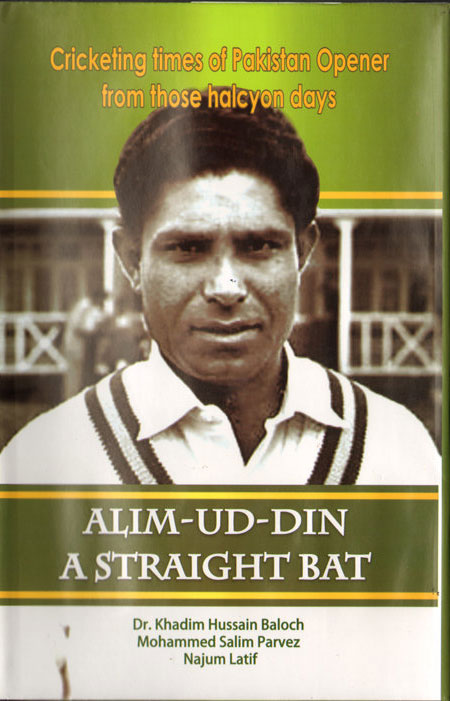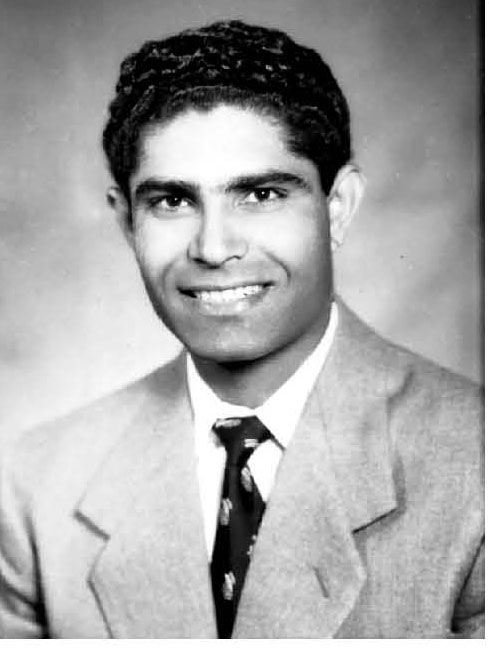|
|
The South
Asian Life & Times - SALT |
|
|||
|
Contents Wildlife
& Adventure
Feature Environment Lifestyle Feature Chef Manish
Chef Vivek Singh Chef Vikram Sunderam
People
Health
Book Reviews In Memoriam
|
|
||||
|
Alim-ud-din: A Straight Bat
By Dr Khadim Hussain Baloch, Mohammed Salim Parvez|
Alim-ud-din A Straight
Bat
is written by a trio who have a real passion for the greatest of all games,
and also for the written word.
A joy to read! Alim was a fascinating
figure in many ways and his story makes an interesting sporting biography.
Alim was born in December
1930 in Ajmer, Rajasthan. His father was an electrical engineer, and Alim
honed his early cricketing skills on the grounds of Mayo College, though he
did not study in this exclusive school.
Alim-ud-din’s break came when he was
selected to play for Rajputana against Delhi in the Ranji Trophy in November
1942. He was only 12 at the time! “His appearance in the semi-finals of the
Ranji Trophy at Baroda in February 1943, was nothing short of being
remarkable especially when one considered the quality of the players in the
field - Vijay Hazare, Cottari Nayudu, Hemu Adhikari, Mutyalswami Naidu,
Wyankatrao Ghorpade, Raosaheb Nimbalkar and Vivek Hazare! Though Rajputana
was annihilated by Baroda, Alim scored the highest number of runs - 13 in
the first innings and 27 in the second -before being stumped.” He became the
youngest player ever to play first class cricket and created a world record.
Cricket eventually led Alim to Bombay,
where his elder brother lived. It was in Bombay that he met a person who was
to have considerable influence on his life. “No sooner had I arrived in
Bombay than I decided to go to the Sunder Cricket Club to play in the nets.
It was here that I met Zulfiqar Ali Bhutto, who was a member of the club and
lived somewhere in Worli.”
(Former England captain, Douglas Robert
Jardine was also born here). The family moved to Karachi, Pakistan in early 1948. A right-hand opening bat,
Alim-ud-din, was among the first generation of Pakistan cricketers. As an
opening batsman, he successfully held off both pace and spin, at home and
away on matting and turf.
After arriving in Karachi, Pakistan’s capital city
at the time, Alim had the distinction of facing the opening delivery against
the first touring team in 1948 – John Goddard’s West Indies side – for Sindh
at Karachi Gymkhana. He was also the opening batsman on his country’s first
overseas tour to Ceylon in 1948-49. Alim-ud-din played 25 Test matches for Pakistan, and
140 First Class matches in his cricketing career. Dr Baloch writes about
the impact ‘Vinoo’ Mankad, skipper A.H. Kardar, and Zulfiqar Ali Bhutto, had
on Alim’s life, both on and off the cricket field.
In a conversation with Dr Baloch, while
sitting in the Press Box at Lord’s, Alim spoke with great respect about
Vinoo Mankad, his mentor and coach. “He was the toughest and most
single-minded of all my coaches. In the final analysis, it was not India
that reaped the benefits of what Mankad taught me but Pakistan.” Short and stocky with dark complexion and curly hair, Alim, or ‘Munaee’ to his family, was one of the best-dressed cricketers of the time, a man of high taste, who would often drop in at Harrods for tea, when in London. Asif Iqbal reaffirms this in his foreword: “My first meeting with Alim Bhai, as we all knew him, was in India. I was a teenaged seamer opening the bowling for South Zone against the
Pakistan team which was
touring India under the captaincy of Fazal Mahmood. I still remember that my
first impression about him was that he must have been one of the most
well-dressed cricketers I had ever
encountered and that impression remained even as my cricketing experience
grew and became much wider than it was in those early years of my cricketing
life.“
Asif adds, “When I migrated from India to
Pakistan a couple of years later, I was happy to find that Alim Bhai was the
first captain I played under in Pakistan when I was selected to play for one
of the Karachi teams. In those days the Karachi Cricket Association used to
field at least two and sometimes even three teams in the Quaid-e-Azam
Trophy, designated as Whites, Greens and Blues. He was always full of
encouragement and helpful advice for youngsters and I found the advice he
gave us of great use, some of which served me well all my life, both on and
off the field.” “After his cricketing career was over, Alim Bhai
migrated to the UK and served for many years with Pakistan International
Airlines at Heathrow airport. For Pakistani cricketers, old and young, Alim
Bhai would be first port of call while travelling to and from London.
Indeed, he was a pillar of the Pakistani cricketing fraternity in the UK and
a pillar of strength for his family for whom he made innumerable
sacrifices.”
Alim-ud-din: A Straight
Bat
transports one to a world of nostalgia, of old-world values and an age of
innocence. Najum Latif, a Punjab University player, Research Scholar,
cricket historian and founding curator of Pakistan’s first Cricket Museum in
the pavilion of Bagh-i-Jinnah, Lahore, recalls the excitement that
surrounded The Lahore Test against India in January, 1955. “Eastern Optical,
a shop in the Dinga Singh Building on the Mall, offered Binoculars for
Rs.5/- to watch the test match. Sutlej Cotton Mill Okara owned by the
Dalmias announced prize money of Rs.500/- for a Pakistan player who would
make a ton. Lahore Cloth merchants M/s Ramzan Bhai and Bashir Bhai offered
Rs.200/- to any Pakistani player who scored a century.” More importantly, Najum Latif has recreated the
excitement of key matches and series with India, Australia, West Indies, and
England played at home or away – until the 60s. Great names come alive and
adrenalin recirculates. Alim-ud-din passed on in England in July, 2012, aged
81years. His death leaves Pakistan with only four survivors - Hanif
Mohammad, Imtiaz Ahmed, Waqar Hasan & Wazir Mohammad - of the famous Oval
win against England in August 1954. For the first time a biography of this calibre has
been written in English on a Pakistani cricketer, by Pakistani writers. An immensely enjoyable
book, Alim-ud-din: A Straight Bat
takes one through the early decades of post-partition cricket in Pakistan.
|
|||||
|
Copyright © 2000 - 2015 [the-south-asian.com]. Intellectual Property. All rights reserved. |
|||||

